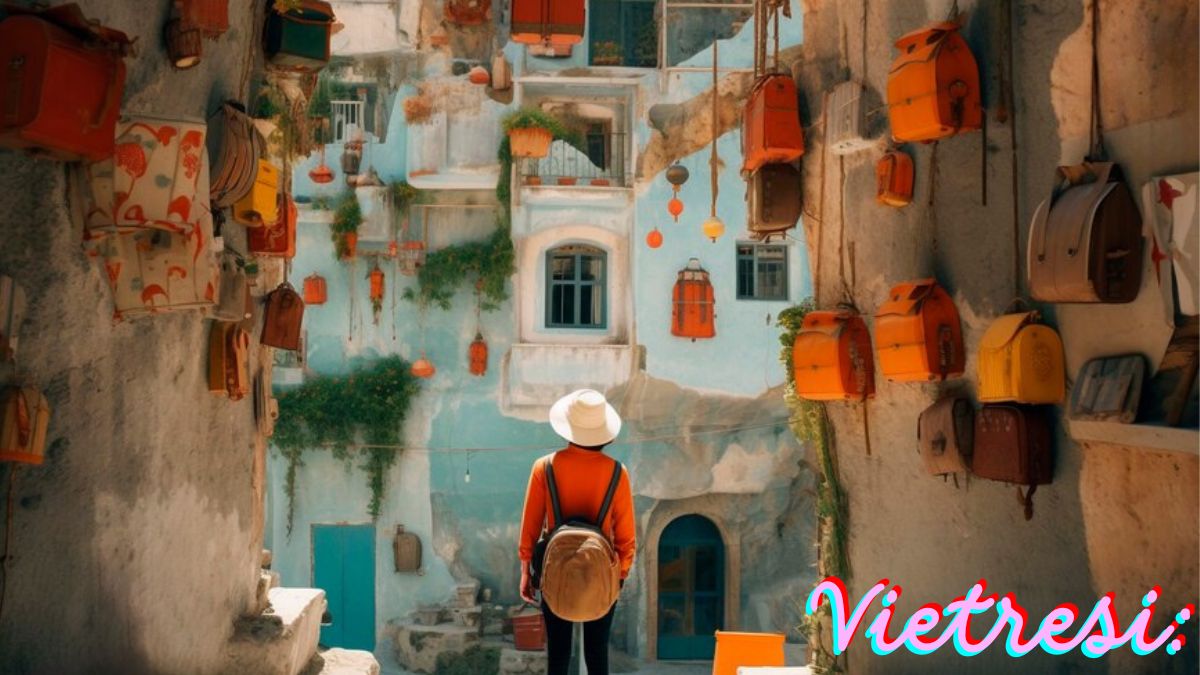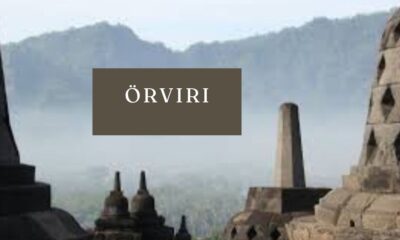CULTURE
Unveiling Örviri: An Exploration of Its Mystical Charm and Cultural Significance

Örviri is a term that has significance in certain cultural contexts, but it could be unfamiliar to many. This study aims to delve into these features in order to discover the cultural importance, origins, and mystery charm of Örviri. An attractive subject for inquiry is Örviri due to the rich web of stories and interpretations around it, which extends from folklore to modern understandings.
What is Örviri?
Örviri is often portrayed as a magical or enchanted realm, item, or idea, contingent upon the cultural setting. The exact connotation of the word could change depending on where you look, but in most contexts it conjures up images of magic, awe, and mystery. A mythological country, an enchanted object, or a state of being might be what Örviri means in different cultures.
Historical Origins of Örviri
Ancient Folklore
Legend had it that this world was teeming with mysteries, riches, and obstacles that, on occasion, one had to overcome in order to find wisdom or good fortune. Oral traditions often included the transmission of stories about Örviri from one generation to the next.
Mythological Significance
Örviri is depicted in many mythology as either a paradise where humans may, under certain conditions, travel or as a realm where the gods reside. A hero or seeker commonly faces challenges and tribulations on their mission to locate Örviri in these legendary stories. The voyage represents the quest for greater understanding, self-improvement, and illumination.
You might also like:Exploring the Vibrant Culture and Rich Heritage of Vietnam
Cultural Significance of Örviri
In Literature and Art
Örviri has been a source of inspiration for many literary works and artistic expressions. Authors and poets have used the concept to create rich, imaginative worlds that captivate readers and convey deeper philosophical or spiritual messages. Similarly, artists have depicted Örviri in paintings, sculptures, and other forms of visual art, often highlighting its mystical and otherworldly qualities.
In Modern Interpretations
In contemporary times, Örviri’s continues to capture the imagination of people across the world. It is often referenced in fantasy literature, movies, and video games, where it serves as a backdrop for epic adventures and quests.
The Mystical Charm of Örviri
Symbolism and Themes
Örviri is rich in symbolism, often representing the unknown, the mysterious, and the mystical. It embodies themes such as the journey of self-discovery, the pursuit of hidden knowledge, and the exploration of the subconscious mind. These themes resonate deeply with people, as they reflect universal human experiences and aspirations.
Enchantment and Wonder
The allure of Örviri’s lies in its enchantment and the promise of discovering something extraordinary. This sense of wonder and enchantment is what makes Örviri so captivating and timeless.
Örviri in Popular Culture
Fantasy Literature
It is common to see Örviri’s portrayed as a magical, secret region in fantasy literature, where heroes and adventurers go in search of adventure. By combining aspects of magic, intrigue, and adventure, these novels bring readers to faraway realms while capturing the spirit of Örviri.
Movies and Television
In the world of cinema and television, Örviri’s serves as an ideal setting for fantasy and adventure genres. It provides a rich and imaginative backdrop for epic stories, allowing filmmakers to explore themes of heroism, exploration, and the supernatural.
Video Games
Video games have also embraced the concept of Örviri’s creating immersive worlds where players can embark on quests and adventures. These virtual realms often draw inspiration from the mythical and enchanted aspects of Örviri’s, offering players a chance to experience the thrill of discovery and the wonder of the unknown.
The Philosophical and Spiritual Dimensions of Örviri
Personal Growth and Enlightenment
It represents the inner quest for self-discovery and the pursuit of higher knowledge. This philosophical dimension of Örviri resonates with individuals seeking meaning and purpose in their lives, encouraging them to explore their inner worlds and unlock their potential.
Connection to Nature and the Cosmos
Örviri’s is also linked to a profound affinity for the natural world and the universe at large. It represents long-held cultural values that highlight the interdependence of all things and the need of maintaining a balanced relationship with nature.
The Timeless Appeal of Örviri
Universal Themes
The themes and symbolism associated with Örviri’s are universal, transcending cultural and temporal boundaries. They tap into fundamental human experiences and aspirations, making Örviri’s a timeless concept that continues to captivate and inspire. Whether through ancient folklore or modern media, Örviri remains a powerful symbol of the unknown, the mystical, and the extraordinary.
Inspiring Imagination and Creativity
A quality that has stood the test of time for Örviri’s is its capacity to ignite creativity and imagination. Dreaming big, venturing out, and testing one’s creative limits are all things it promotes. Many literary and artistic works demonstrate the boundless potential of human creation by using the idea of Örviri.
Conclusion
Örviri has captivated people for generations with its intriguing and complex premise. It represents the fascination with the mysterious and the unfathomable, stretching from its roots in old folklore and mythology to its appearance in contemporary literature, art, and media. A sign of enduring wonder and enchantment, it speaks to people’s deepest desires for self-discovery, personal progress, and the quest for more knowledge. Örviri, in all its forms—mythical region, enchanted item, or state of being—keeps captivating and inspiring, beckoning us to delve into the enigmas that exist beyond the mundane.
CULTURE
Çeciir: Exploring the Mystique and Heritage

Çeciir, a term rich in history and cultural significance, has captivated many for generations. Rooted in tradition and enriched by various interpretations, Çeciir represents more than just a cultural artifact; it embodies the spirit and heritage of a people. Understanding its origins and evolution is crucial to appreciating its place in today’s world.
Historical Background
The earliest records of Çeciir date back centuries, where it was mentioned in ancient manuscripts and oral traditions. Initially, Çeciir’s played a vital role in communal gatherings and rituals, serving as a symbol of unity and identity. Over time, its significance grew, evolving to include various forms and meanings as it spread across different regions.
Cultural Significance
In local traditions, Çeciir’s is more than a mere object or concept; it is a symbol of cultural pride and continuity. It holds deep meaning, often associated with themes of resilience, unity, and spiritual connection
Geographical Roots
Çeciir is deeply tied to specific regions, each contributing unique elements to its overall identity. The geographical diversity has influenced its development, leading to variations that reflect the local environment and cultural practices. Understanding these roots provides insight into the multifaceted nature of Çeciir’s.
Artistic Expressions
The presence of Çeciir’s in literature and folklore is profound. Poets and writers have drawn inspiration from its symbolism, crafting stories that resonate with its themes. Visual arts, too, have captured Çeciir’s essence, depicting it in paintings, sculptures, and crafts that celebrate its cultural importance.
Modern Interpretations
Today, Çeciir continues to find relevance in modern contexts. It has been embraced in various forms, from contemporary art to fashion, symbolizing a bridge between past and present. Its presence in popular culture underscores its enduring appeal and adaptability.
Language and Etymology
The term Çeciir itself has fascinating linguistic roots. Derived from ancient dialects, it has seen variations across different languages and regions. Understanding its etymology reveals the interconnectedness of cultural and linguistic histories.
Cultural Festivals and Celebrations
Çeciir is celebrated in numerous festivals, each showcasing its significance through elaborate ceremonies and festivities. These events are not just cultural displays but also opportunities for communities to come together, reaffirming their shared heritage and identity.
Preservation Efforts
Efforts to preserve Çeciir are underway, spearheaded by cultural organizations and museums. These initiatives aim to protect and promote the heritage associated with Çeciir’s, ensuring that future generations can appreciate its value. Documentation, education, and community involvement are key to these efforts.
Educational Importance
Incorporating Çeciir’s into educational curriculums is essential for its preservation. Teaching the younger generations about its history, significance, and relevance fosters a deeper appreciation and ensures that its legacy continues. Schools and educational programs play a pivotal role in this process.
Impact on Tourism
Çeciir has also impacted tourism, attracting visitors eager to learn about its rich cultural heritage. Tourist attractions and cultural sites related to Çeciir provide economic benefits to local communities, promoting cultural tourism and awareness.
Personal Stories and Anecdotes
Personal stories and anecdotes bring Çeciir to life, offering glimpses into how it has touched individual lives. These narratives, whether inspiring or anecdotal, highlight the personal connections people have with Çeciir’s, adding depth to its cultural significance.
Challenges and Controversies
Despite its rich heritage, Çeciir’s faces challenges and controversies. Debates around its authenticity and modern adaptations sometimes spark discussions about cultural purity and preservation. Addressing these challenges is crucial for maintaining the integrity of Çeciir’s legacy.
Future Prospects
Looking ahead, Çeciir has the potential for revival and growth. As interest in cultural heritage continues to rise, Çeciir can find new avenues for expression and appreciation. Predictions for its future suggest a continued, if not increased, role in cultural narratives.
Conclusion
Çeciir is more than a cultural artifact; it is a symbol of identity, unity, and heritage. Its rich history, cultural significance, and modern relevance make it a fascinating subject of study and appreciation. By understanding and preserving Çeciir, we honor the past while enriching the present and future.
FAQs
What is Çeciir?
Çeciir’s is a term that represents a significant cultural heritage, embodying various traditions, symbols, and meanings across different regions.
Why is Çeciir important?
Çeciir is important because it symbolizes cultural identity, unity, and heritage, playing a crucial role in preserving traditions and fostering community spirit.
How can Çeciir be preserved?
Preservation efforts for Çeciir include documentation, education, community involvement, and support from cultural organizations and museums.
What are some famous Çeciir festivals?
Famous Çeciir’s festivals are celebrated in various regions, each featuring traditional ceremonies, performances, and community gatherings that highlight its cultural significance.
How can I learn more about Çeciir?
To learn more about Çeciir’s, you can visit cultural museums, attend festivals, read literature and folklore, and engage with local communities that celebrate this heritage.
CULTURE
Vietresi: Exploring the Vibrant Culture and Rich Heritage of Vietnam

Where each turn reveals a new tale, each bite tantalizes your taste buds, and each encounter fills you with awe—isn’t that the kind of place you’ve always imagined? Step right into Vietresi! Visiting Vietresi is like taking a trip through the very essence of Vietnam; it’s more than simply a place on a map. Vietnam is a must-see tourist destination because to its rich history, stunning landscapes, and vibrant modernity, all of which shine like a light.
Historical Background
Ancient civilizations, colonial influences, and contemporary tenacity all weave together to form Vietnam’s complex tapestry of history. Many different civilizations have called Vietnam home, starting with the illustrious Hong Bang Dynasty and continuing through the Dai Viet and Champa dynasties. There is a perfect blending of Western and Eastern styles brought forth by the French colonial era. The unification of North and South Vietnam in 1975 was the culmination of the turbulent 20th century. As it moves forward toward a bright future, Vietnam today celebrates its complex history.
Ancient Civilizations in Vietnam
History in Vietnam is just as varied and fascinating as the country’s scenery. The fabled Hong Bang Dynasty, often regarded as the earliest Vietnamese kingdom, is where Vietnam’s history starts, thousands of years ago. Between the great Dai Viet dynasty and the ancient Champa kingdom, Vietnam has been a cultural crossroads for many years. The country’s culture, architecture, and customs were profoundly impacted by each age.
You might also like :https://vapespen.com/
Colonial Influences and Modern History
French colonists arrived in Vietnam in the middle of the nineteenth century, bringing with them a fusion of Western and Eastern culinary and architectural styles. The independence movements of the twentieth century brought Vietnam’s North and South halves back together in 1975. As it continues to modernize, Vietnam proudly celebrates its complicated past.
Geographical Diversity
From the northernmost terraced rice fields of Sapa to the southernmost sandy beaches of Nha Trang, the geographical variety of Vietnam is breathtaking. Vietnam is home to some breathtaking landscapes, such as Ha Long Bay’s limestone karsts, the Mekong Delta’s fertile plains, and the Central Highlands’ verdant forests.
The Landscapes of Vietnam
A diverse array of landscapes forms the fabric of Vietnam’s topography. Stunning landscapes await you around every corner of the nation, from Sapa’s terraced rice terraces to Nha Trang’s sandy beaches. Natural beauty is on display in the stark contrast between Ha Long Bay’s limestone karsts and the verdant Mekong Delta.
Climate and Best Times to Visit
The weather in the north and south of Vietnam is quite different from one another. Cold winters and scorching summers are two of the four seasons that the north endures. Southern regions have a tropical climate characterized by high temperatures throughout the year and a wet season that lasts from May to November. The weather in Vietnam is often at its nicest in the spring (February–April) and fall (August–October), however this really depends on your plans for the trip.
Cultural Significance
The diverse traditions, rituals, and festivities of Vietnam are the very foundation of its cultural importance. Family, reverence for one’s elders, and veneration of one’s ancestors are central to Vietnamese culture, which draws from Confucianism, Buddhism, and Taoism. The country’s rich history and strong sense of community are on full display during festivals like Tet, the Lunar New Year, and the Mid-Autumn Festival.
Traditions and Customs
Buddhism, Confucianism, and Taoism are the three main tenets of Vietnamese culture. Respect for one’s ancestors and elders is vital in Vietnamese culture, which centers on the family. Holidays like Tet (Lunar New Year) emphasize being together as a family, honoring the dead, and welcoming in the new year.
Festivals and Celebrations
Countless lively events take place throughout Vietnam. Fireworks, feasts, and lion dances mark the most important holiday, Tet Nguyen Dan, which is also known as the Lunar New Year. Other important community gatherings include the Hue Festival, which highlights the cultural history of the historic capital, and the Mid-Autumn Festival, which is characterized by lantern parades and mooncakes.
Vietnamese Cuisine
Flavors, smells, and textures abound in Vietnamese food, which is renowned for its harmonious combination of sweet, sour, salty, bitter, and umami. Classic Vietnamese cuisine like pho (noodle soup), banh mi (sandwich), and goi cuon (spring rolls) rely heavily on fresh herbs, rice, and noodles.
Introduction to Vietnamese Food
Flavors, smells, and textures all come together in perfect harmony in Vietnamese food. Its signature harmony among the five basic flavors—sweet, sour, salty, bitter, and umami—has made it famous. Many meals rely on fresh herbs, rice, and noodles, which showcases the country’s abundant agriculture.
Popular Dishes and Regional Specialties
Vietnamese cuisine is varied and flavorful, with dishes ranging from the famous noodle soup (pho) to the savory banh mi sandwich. Vietnamese cuisine is known for its regional specialties, which range from fiery meals from Central Vietnam to substantial tastes from the north to sweet and sour notes from the south. In Hanoi, you must have bun cha, which consists of barbecued pork served with noodles. In Da Nang, you must indulge in the seafood pleasures.
Street Food Culture
Legend has it that Vietnam has the best street food. Vendors selling anything from spring rolls (goi cuon) to crispy pancakes (banh xeo) may be seen strolling through busy marketplaces. Indulging in street food in Vietnam is a great way to experience real local cuisine and culture.
Language and Communication
Vietnamese Language Basics
The Vietnamese language is officially recognized, however due to the country’s colonial past, some elder generations still speak French. Improving your vacation experience may be as simple as learning a few basic words in Vietnamese. You may communicate with locals much more effectively by using simple pleasantries such as “Xin chào” (hello) and “Cảm ơn” (thank you).
Tips for Communicating with Locals
Schools and towns with a high concentration of tourists speak English, but if you go to more remote locations, you may find that the language is more difficult to understand. Smiling and gesturing are forms of non-verbal communication that may convey a lot. Any communication obstacles may be overcome with positivity and patience.
Iconic Landmarks
Ha Long Bay
Ha Long Bay, a UNESCO World Heritage Site, is renowned for its emerald waters and thousands of limestone islands topped with rainforests. A cruise through the bay is a quintessential Vietnamese experience.
Hoi An Ancient Town
Hoi An, with its well-preserved architecture and lantern-lit streets, transports visitors back in time. This historic town is famous for its tailor shops, traditional crafts, and the monthly Lantern Festival.
Cu Chi Tunnels
The Cu Chi Tunnels offer a glimpse into Vietnam’s wartime history. This vast network of underground tunnels was used by Viet Cong soldiers during the Vietnam War and is now a popular tourist attraction.
Mekong Delta
The Mekong Delta, known as the “Rice Bowl of Vietnam,” is a lush, fertile region where life revolves around the river. Boat tours allow you to explore the floating markets, rice paddies, and traditional villages.
Natural Wonders
Phong Nha-Ke Bang National Park
Son Doong, the biggest cave on Earth, is one of several breathtaking caverns found inside this UNESCO World Heritage Site. The park is an adventurer’s dream because to its subterranean rivers and karst terrain.
Fansipan Mountain
Fansipan, known as the “Roof of Indochina,” is the highest peak in Vietnam. Trekking to its summit offers stunning views and a sense of accomplishment, attracting hikers from around the world.
Con Dao Islands
The Con Dao archipelago is a hidden gem with pristine beaches, coral reefs, and a rich history. Once a French colonial prison, Con Dao is now a haven for nature lovers and history buffs alike.
Modern Vietnam
The Bustling Cities of Hanoi and Ho Chi Minh City
The capital, Hanoi, combines modernism with old traditions. The Old Quarter is a labyrinth of winding alleys, while the French Quarter is home to structures from the colonial period. Famous for its skyscrapers, retail areas, and lively nightlife, Ho Chi Minh City (formerly Saigon) is the economic core of Vietnam.
Contemporary Art and Music Scenes
As a whole, Vietnam’s modern music and art communities are booming. Live music venues in Hanoi and Ho Chi Minh City provide a wide range of musical styles, from traditional Vietnamese music to current indie rock and electronic dance music (EDM). Galleries in both cities also include works by known and rising artists.
Traditional Arts and Crafts
Vietnamese Silk and Textiles
The quality and artistry of Vietnamese silk are well-known across the globe. Near Hanoi, in a village called Van Phuc, locals have been weaving silk for generations, and tourists may see the process firsthand while shopping for exquisite materials.
Pottery and Ceramics
The village of Bat Trang, near Hanoi, is famous for its ceramics. Here, you can watch artisans create intricate pottery and even try your hand at the potter’s wheel.
Water Puppetry
Water puppetry is a unique Vietnamese art form dating back to the 11th century. These shows, performed in water-filled stages, depict scenes from rural life and ancient legends, accompanied by traditional music.
Travel Tips
How to Get Around Vietnam
From bicycles and motorcycles to buses and railroads, Vietnam has a wide range of transportation options. Additionally, greater distances may be covered by domestic planes. Riding a motorcycle is a fun and exciting way to see the world, but before you do, research the rules of the road in your destination.
Safety Tips for Travelers
It is advisable to take precautions when visiting Vietnam, even if it is typically safe. Particularly in busy places, keep a close check on your possessions. Always use caution while crossing roadways and stay off country roads after dark. Another tip for staying hydrated and avoiding indigestion is to use bottled water.
Budgeting for Your Trip
Traveling to Vietnam won’t break the bank. You can get tasty, cheap street cuisine, a wide variety of places to stay (from hostels to five-star hotels), and the public transit system is easy on the wallet. Vietnam is a great place to visit if you’re looking for a bargain, but how much you spend depends on your travel style.
Accommodation Options
Luxury Hotels and Resorts
From Hanoi and Ho Chi Minh City’s five-star hotels to Phu Quoc’s seaside resorts, Vietnam is home to some of the world’s finest luxury hotels. If you’re looking for a five-star experience throughout your visit, these places are perfect.
Homestays and Hostels
Think about doing a homestay if you want to get a feel for the local culture. You may experience local life firsthand by staying with a local family. Another option is to stay at one of the many hostels, which provide cheap rooms and a great chance to meet other visitors.
Eco-Friendly Lodging
Eco-tourism is on the rise in Vietnam. Many eco-lodges and sustainable hotels are located in natural settings, promoting conservation and offering unique experiences like staying in treehouses or bamboo huts.
Shopping in Vietnam
Traditional Markets and Night Bazaars
Vietnamese markets are vibrant hubs of activity. Ben Thanh Market in Ho Chi Minh City and Dong Xuan Market in Hanoi are perfect for buying local produce, handicrafts, and souvenirs. Night markets offer a lively atmosphere with food stalls and entertainment.
Handicrafts and Souvenirs
Vietnam is famous for its handicrafts, including lacquerware, embroidery, and conical hats (non la). These items make great souvenirs and gifts, representing the country’s rich artisanal heritage.
Modern Shopping Malls
For a more contemporary shopping experience, visit one of Vietnam’s modern malls. Vincom Center and AEON Mall offer a mix of international brands, local boutiques, and dining options.
Unique Experiences
Cooking Classes and Food Tours
Cooking classes and food tours are fantastic ways to dive into Vietnamese cuisine. Learn to make traditional dishes like pho and spring rolls under the guidance of local chefs, and explore bustling markets with knowledgeable guides.
Adventure Activities
Vietnam offers numerous adventure activities, from trekking in the northern highlands to kitesurfing in Mui Ne. Caving, kayaking, and motorbiking are popular choices for thrill-seekers.
Cultural Immersion Programs
Cultural immersion programs provide deeper insights into Vietnamese life. These programs may include staying with local families, participating in community projects, or learning traditional crafts and farming techniques.
Conclusion
Vietnam, often known as Vietresi, is a mysterious and fascinating country. No other destination can compare to it in terms of history, scenic diversity, cultural vitality, and welcoming hospitality. Vietnam is a great destination for anybody interested in history, cuisine, adventure, or just seeing the world through fresh eyes. In that case, gather your belongings and go on an adventure to Vietresi, where you may find a tale around every corner.
-

 LIFE STYLE6 months ago
LIFE STYLE6 months agoExploring the World: A Journey with myfavouriteplaces.org
-

 EDUCATION6 months ago
EDUCATION6 months agoλιβαισ: Unraveling the Cultural Enigma
-

 BUSINESS6 months ago
BUSINESS6 months agoRetra: Revolutionizing Workflow Management
-

 TECHNOLOGY6 months ago
TECHNOLOGY6 months agoUnlocking the Potential: Exploring the Power of GPT66X
-

 VAPE5 months ago
VAPE5 months agoHush Absolute Vape: Elevate Your Vaping Experience
-

 HEALTH & FITNESS6 months ago
HEALTH & FITNESS6 months agoUnderstanding Blisterata: Causes, Symptoms, and Treatment
-

 VAPE6 months ago
VAPE6 months agoUnderstanding the Lost Mary Vape Phenomenon
-

 VAPE5 months ago
VAPE5 months agoRaz Vape: Revolutionizing the Vaping Experience












